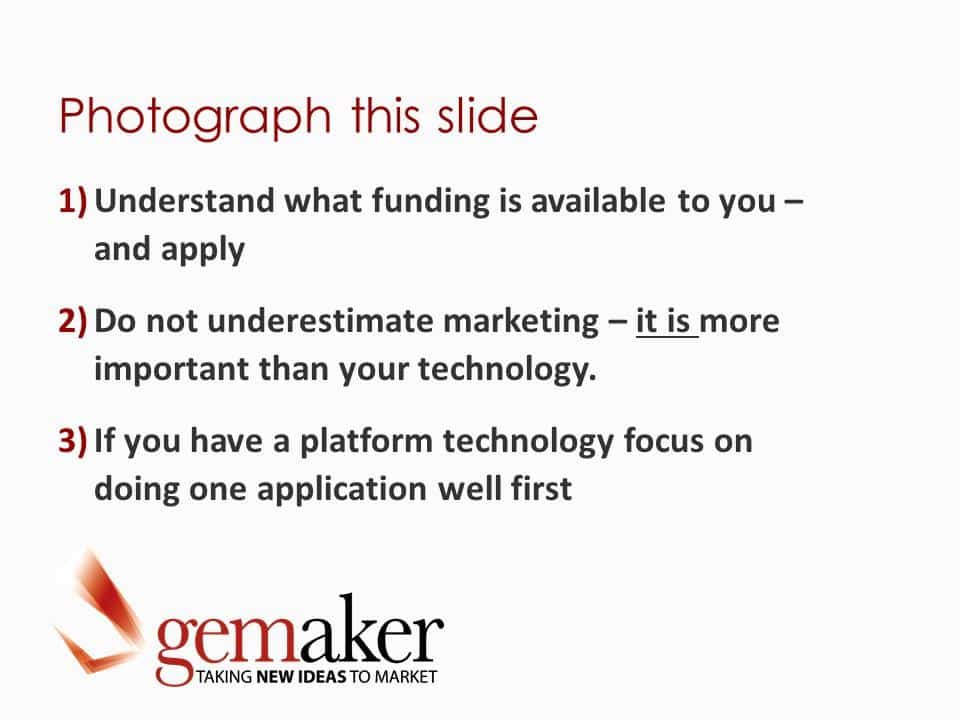Commercialising your innovation: fund, market and focus…or fail
I’ve spent a good part of the last 16 years helping researchers and innovators bring their ideas out of the lab and into the market. I’ve witnessed the development of numerous innovations from ideas through to tests, prototypes and scale-ups, to product sales and spin-off companies. I’ve seen commercialisation plans succeed while others fail, and analysed the reasons for both outcomes.
Consistently, I’ve observed that inventions take more time and money (often hundreds of thousands to millions of dollars) than expected to reach their markets. For STEM-based innovations, ten or more years is a normal development timeframe. There’s no such thing as an overnight success, but to accelerate the process as much as possible, I want to share some of the wisdom I’ve collected.
I could roll off a long list of dos and don’ts, but I believe it’s more helpful to focus on three major factors that can make or break your commercialisation: funding, marketing, and focus (the latter applying to platform technologies – more on that in tip #3). The impact of these factors is frequently underestimated.

Tip 1: Find out what funding you can access for every stage of commercialisation
You might be amazed by the amount of support available to bridge the gap from research discovery to commercial outcome.
Companies, don’t forget the R&D Tax Incentive to get cash back for your R&D expenses. Too often, I am introduced too late to a company that has spent in excess of AU$500K on R&D, in ignorance of the Incentive and the recordkeeping required for an eligible claim. Seek early expert advice on this from an R&D tax specialist.
Companies can access funding for minimum viable products through state-based programs and feasibility and development of prototype or proof of concept with federal and state Government programs that seek innovative solutions – such as the challenges set by the Defence Science and Technology Group, Australian Government – Department of Agriculture and Water Resources and the Queensland Government. These programs typically fund four to five solutions with AU$100-250K for technical proof of concept and then AU$500K-$1M for commercial proof of concept. This is a fantastic way to accelerate your technology along its commercialisation pathway because it also provides a trial customer.
In addition, there are numerous incubators and accelerator programs, university seed funding, Industry Growth Centres, medical sector funding, Accelerating Commercialisation grants, angel investors and venture capitalists. While the success rate for Australian Research Council grant applications is typically 15%, the success rate for applications to some of these funding sources is 50% to 90%. But don’t attempt to alter your project or shoehorn it into selection criteria for a funding application – it’s a waste of time and rarely succeeds.
Tip 2: Don’t underestimate the need for marketing
As a scientist, I used to be guilty of this, but after sixteen years in commercialisation, I appreciate marketing’s awesome power.
Most researchers and inventors think the product is the most important thing in business. It’s not; the customer is. If they don’t want what you have, think it’s too expensive or too difficult to use or buy, don’t understand it, or if they’ve simply never heard of it, then you won’t make sales. Marketing is not just promotion, it’s creating a product that customers will want, at a price they’ll pay, in a location (real or virtual) they’ll visit.
In my experience, marketing is the difference between success and failure. I’ve worked with clients who, despite having superior products, multiple advantages and customer trials, have failed to get customers because they’ve underestimated the importance of marketing.
Tip 3: Platform technology is a double-edged sword, so stay focused
I’ve worked on numerous platform technologies which offer almost limitless potential…but this can lead to self-defeating distraction.
When you’re starting up, you need customers to trial your technology. Having several case studies with robust results to present to potential clients, investors and regulators is crucial with disruptive technologies. No one will replace what they have with what you’re selling, unless you have solid evidence that they should. But simultaneously trialing a dozen different applications in a dozen different countries isn’t a great plan when you have limited budget. It’s vital to quickly compare options and determine the best primary market to enter with your technology and focus on doing that well. You can then progressively enter other markets once you have credibility and sales in your first market. Otherwise, it’s like hoping to land a senior corporate sales role because you once ran a lemonade stand.
I offer these three tips to smooth and straighten your path to commercialisation. Australia needs creative people like you to improve our quality of life, nurture the health of our planet, and grow the new industries on which our future wellbeing will depend. I wish you success. Let me know how you go.

Natalie shared her tips at an event held by IP Australia in partnership with the Australian National University’s Technology Transfer Office – Protect, publish, engage: stories about collaboration and commercialisation.
About the Author
 This insights article is contributed by Natalie Chapman, Managing Director of gemaker. Natalie leads the gemaker team with over 15 years commercial experience developing new products and services for market across the education, financial, scientific and engineering consulting sectors. A commercialisation whiz and a talented manager, Natalie believes in building a deep understanding of customer needs to drive market success.
This insights article is contributed by Natalie Chapman, Managing Director of gemaker. Natalie leads the gemaker team with over 15 years commercial experience developing new products and services for market across the education, financial, scientific and engineering consulting sectors. A commercialisation whiz and a talented manager, Natalie believes in building a deep understanding of customer needs to drive market success.
Great article from Natalie with plenty of useful insights
Mark Prentice May 10, 2019Comments are closed.